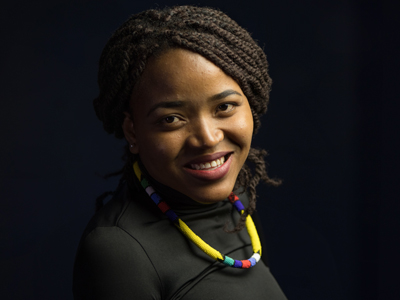Meet Valentine Saasa
 Valentine Saasa is PhD candidate and is based at the CSIR Materials and Manufacturing unit (Nanocentre). She regards unemployment as an issue that is close to her heart. In order to help address and contribute towards minimising this problem, she has started an NGO which focuses on promoting and instilling a STEM interest in learners. She shares her insights on this and, on how young people at the CSIR can help contribute towards the organisation’s renewal plans among other topics.
Valentine Saasa is PhD candidate and is based at the CSIR Materials and Manufacturing unit (Nanocentre). She regards unemployment as an issue that is close to her heart. In order to help address and contribute towards minimising this problem, she has started an NGO which focuses on promoting and instilling a STEM interest in learners. She shares her insights on this and, on how young people at the CSIR can help contribute towards the organisation’s renewal plans among other topics.
Name: Valentine Saasa
Job title: PhD Candidate
What do you think the future holds for you as a young person?
The future looks good. There are a lot of opportunities, especially with the new industrialisation direction that the CSIR is now taking. Personally, I feel it will create opportunities for me to engage with industry experts who can be potential investors. This will push most of us to be familiar with the business world and integrate both research and industry needs. As a scientist, I will be able to move in any direction; either continue with academics or move to industry.
What kind of future do you envision for the country and how do you think the youth can help shape it?
A country with no unemployment, especially for graduates who hold at least a varsity qualification. Unemployment is very close to my heart as most people I went to school with who have a master’s degree in the science, technology, engineering and mathematics (STEM) fields but are unemployed.
I think it is high time the youth start doing things for themselves, instead of waiting for employers. They can start their own NGOs or SMMEs. There are a number of support programmes for youth who have small companies or NGOs or innovative ideas. We have the National Research Fund (NRF) and the South African Agency for Science and Technology (SAASTA), which funds science promotions; we have DST, which funds any science centre established by anyone, despite age or gender. We have the National Lottery, the Technology Innovation Agency, which provides the youth with incubation funds and seed funding to help them stand on their feet.
South Africa has one of the highest unemployment rates among the youth. If you were tasked with helping to find solutions to address this issue, what would they be?
Unemployment is close to my heart. I am already trying to help the country to minimise unemployment through my NGO, which focuses on promoting and instilling an interest in STEM in learners and most importantly improving the quality of pass-marks in STEM. The organisation applies for funds for mentorship, promotion of STEM, hosting of the National Science Week by hiring unemployed graduates with STEM to facilitate all the interventions. Currently, the funding we manage to attract is not enough to eradicate unemployment, but we hope that if we can attract a funding contract of over five years, it will yield better long-term results by reducing unemployment and improving the quality of STEM results in basic education.
Name one great achievement you are most proud of.
In 2016, I was a proud recipient of the South Africa Women in Science Communication Award. The following year, I was a joint recipient of the Department of Science and Technology (DST) Doctoral Award.
Name one young person whose work you are inspired by.
Ludwick Marishane, the youngest patent holder in the country, who invented dry-bath. Seeing that South Africa is a water-scarce country and Cape Town is facing the challenge of drought, his work really has the potential to make an impact within the continent.

